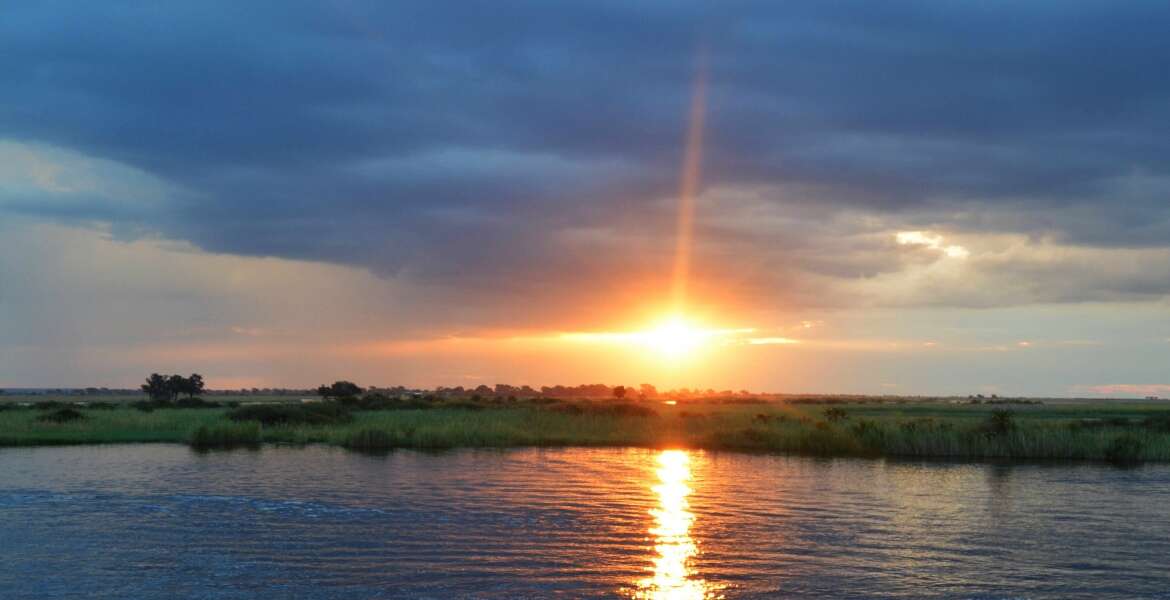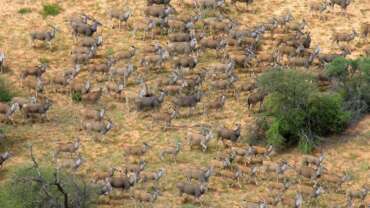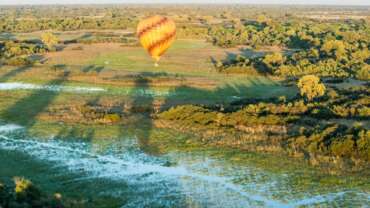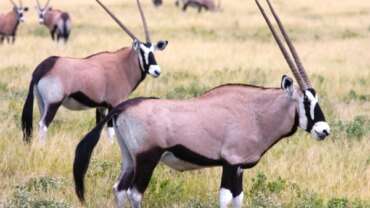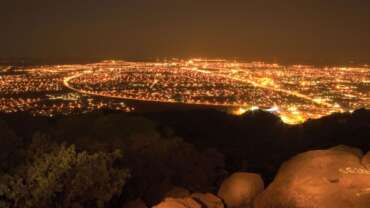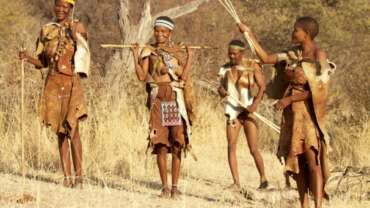Adventure Tourism in Botswana
Chobe National Park
Whether arriving by air or road, the first glimpse of the river – deep and dazzling in the sandy terrain – is always breathtaking. It appears as a swathe of brilliant, peacock blue ribbon, winding its way through the tiny town of Kasane, and ensuing wilderness – the Chobe National Park.
Undoubtedly one of Africa’s most beautiful rivers, the Chobe supports a diversity and concentration of wildlife unparalled anywhere else in the country.
Established in 1968, the park covers approximately 11 7 00 sq kms, encompassing floodplains, swamps and woodland. The Chobe River forms its northern boundary. There are four distinct geographical areas in the park: the Chobe Riverfront, the Ngwezumba pans, Savuté and Linyanti.
The most accessible and frequently visited of Botswana’s big game country, the Chobe Riverfront is most famous for its large herds of elephants and cape Buffalo, which during the dry winter months converge upon the river to drink.
During this season, on an afternoon game drive, you may see hundreds of elephants at one time. You may be surrounded by elephants, as the main Serondella road becomes impassable and scores of family herds cross the main road to make their way to the river to drink, bathe and play.
Driving the loops that hug the river’s edge, you may see up to 15 different species of animals on any one game drive, including waterbuck, lechwe, puku (this is the only part of Botswana where they can be seen), giraffe, kudu, roan and sable, impala, warthog, bushbuck, monkeys and baboons, along with the accompanying predators lion, leopard, hyena and jackal.
Take a river cruise – and you’ll experience the park, and the animals, from another vantage point. Here you’ll get up close and personal with hippo, crocodile and a mind-boggling array of water birds.
Over 460 bird species have been recorded in the park, making it one of Africa’s premier venues for bird Safaris. Common species to be seen include the Sacred ibis, Egyptian Geese, the ubiquitous cormorants and darters, Spur-winged Geese, pel’s Fishing Owl, carmine Bee-eaters, most members of the kingfisher family, all the rollers, the unmistakable Fish Eagle, the Martial Eagle, and many members of the stork family.
The Chobe River rises in the northern Angolan highlands, travels enormous distances before it reaches Botswana at Ngoma. Like the Okavango and Zambezi rivers, the Chobe’s course is affected by fault lines that are extensions of the Great Rift Valley. These three mighty rivers carry more water than all other rivers in Southern Africa.
Lesoma Memorial Monument
In 1977, the brutal civil war in the then Rhodesia spilled over into Botswana. In the process, 15 Botswana Defence Force soldiers died; however, the incident only strengthened Botswana’s national resolve to remain a peace loving nation.
Ngwenzumba Pans
The Ngwezumba pans lie approximately 70 kms south of the Chobe River and comprise a large complex of clay pans, surrounded by mophane woodlands and grassland plains.
During the rainy season, the pans fill with water, then attracting wildlife that move away from the permanent water sources of the Linyanti and Chobe Rivers.
Savute
Truly at the interior of the park, Savuté boasts most of the chobe species, except for water-loving antelope. It is best known for its predators,particularly lion, cheetah and hyena, of which there are large resident populations.
The Savuté channel flows from the Linyanti River for about 100 kilometres, carrying water away from the river and releasing it into a vast swampland called the Savuté Marsh, and further south onto the Mababe Depression, which is also fed by the Ngwezumba River from the northeast. The Mababe – immense and flat and fringed by thickets of trees – was once part of the Makgadikgadi super-lake. When filled with water, it becomes the venue for thousands of migratory birds and animals, particularly large herds of zebra.
Geographically, Savuté is an area of many curiosities. One of its greatest mysteries is the Savuté channel itself, which has over the past 100 year inexplicably dried up and recommenced its flow several times. This irregular water flow explains the numerous dead trees that line the channel, for they have germinated and grown when the channel was dry and drowned when the channel flowed again.
Francistown
The second largest city in the country welcomes you with a handshake and a “Dumilani” (hello/good morning!). Home to many Kalanga natives and often referred to as the Capital of the North, Francistown is a vibrant destination perfect for an overnight during a luxury African safari.
The city was named after the British prospector and miner Daniel Francis, who acquired prospecting licenses in 1869, eventually becoming director of the Tati Concessions Company. Francis and other prospectors often used ancient gold shafts as guiding points for their prospecting, or they simply carried on the mining which had been started in those shafts generations ago. The city is still surrounded by old, abandoned mines.
Today the remains of the Botswana gold rush tell a story about the discovery in the city and can be viewed at the museum. This Botswana city is close to the Tati and Inchwe River confluence, a few kilometres from the Zimbabwe border. The city can be self-explored and is home to restaurants and supermarkets.The main road northwest of Francistown gives passage to Maun and the Okavango Delta, Kasane and Chobe National Park, Livingstone, Zambia and Victoria Falls, Zimbabwe.
Birds and Game Botswana
Birds and Game Botswana an animal orphanage established by Uncharted Africa, Birds and Game Botswana has served as refuge for injured or orphaned wild animals for the past twenty years. A popular outing for local residents and a venue for school trips, it has also helped to educate the public about the country’s wildlife heritage.
Tachila Nature Reserve
Spreading over 8,000 hectares of donated land just under 5km from the Francistown city boundary, Tachila Nature Reserve is a broad-based community project that offers natural, archaeological, historical and cultural attractions unique to Francistown and North East District. Tachila – a Kalanga name meaning ‘saviour of all living things’.
Wildlife species include leopard, hyena, kudu, impala, bushbuck, steenbok, klipspringer, rock dassie and warthog. Eventually, rhino, sable and roan antelope, cheetah, giraffe, zebra, wildebeest and eland will be introduced.
A luxury lodge, with conference centre and restaurant will be built in the reserve; and all structures will be eco-friendly, utilising renewable energy, recycling programmes, grey-water reticulation and organic gardens. Whilst still in the development stages, visitors can now enter the reserve for game drives. This is on a self-drive basis, and on arrangement only. Tel: +267 241-2313, or +267 74- 086-277, email gavshaw@iafrica.com.
Domboshaba
This historic site is situated in the northeast of the country, along the Masunga- Kalamati Road, Domboshaba contains excellent examples of cement-less, stone walling and enclosures; some have been reconstructed by the National Museum archaeologists. It was one of the first National Monuments to be gazetted in the country – in 1938.
The stone wall site dating back to 1450AD, is a conservation area with the most striking, even walls that despite their massive width (some are 2 metres thick) and their beautiful decorative motifs and stylistic variations, both underlining the absolute precision and aesthetic considerations with which they were built. Despite the fact that no cement was used in their construction, some walls have survived intact for centuries.
Further up the hill, the floor plan of what is believed to have been a headman’s or chief’s residence can be seen. And the circular remains of houses that once dotted this community reveal earthen floors with stone edgings.
Many walls have collapsed and the National Museum has prioritised this site for further restoration and development, including improved trail signage, camping and ablution facilities. An easy return day drive from Francistown that doesn’t require four-wheel drive, Domboshaba gives entrance to one of Africa’s greatest empires, and an important cultural heritage of the nation.
Supa Ngwao Museum
Aptly named Supa Ngwao (‘to show culture’ in Setswana), culture vultures can rejoice as the local museum offers exhibitions on the culture and history of the Kalanga people, as well as visuals from the early years of Francistown and Botswana. Located in an old government camp, the Supa-Ngwao Museum serves as an important repository of northern Botswana’s heritage. Its collection includes pottery, woodcarvings, basketry and musical instruments.
Authentic, hand-made crafts can be purchased at the Museum’s Craft Shop, which supports approximately 200 craftsmen/women mostly from the surrounding areas.
Okavango Delta
One of the most sought after wilderness destinations in the world, the Okavango Delta gives entrance to the spectacle of wild Africa such as dreams are made of – the heart-stopping excitement of big game viewing, the supreme tranquility and serenity of an untouched delta, and evocative scenes of extraordinary natural beauty.
A journey to the Okavango Delta – deep into Africa’s untouched interior – is like no other. Moving from wetland to dryland – traversing the meandering palm and papyrus fringed waterways, passing palm-fringed islands, and thick woodland, resplendent with lush vegetation, and rich in wildlife – reveals the many facets of this unique ecosystem, the largest intact inland delta in the world.
The Okavango Delta is situated deep within the Kalahari Basin, and is often referred to as the ‘jewel’ of the Kalahari.
That the Okavango exists at all – deep within this thirstland – seems remarkable. Shaped like a fan, the Delta is fed by the Okavango River, the third largest in southern Africa. It has been steadily developed over the millennia by millions of tonnes of sand carried down the river from Angola.
There are three main geographical areas:
– the Panhandle
– the Delta
– dryland
The Panhandle begins at the Okavango’s northern reaches, at Mohembo, extending down for approximately 80 kilometres. Its corridor-like shape is contained within two parallel faults in the Earth’s crust. Here the river runs deep and wide and the swamps are perennially flooded. The dominant vegetation is vast papyrus beds and large stands of phoenix palms. The main tourist attractions of the Panhandle are fishing, birding and visiting the colourful villages that line its western fringes.
At Seronga, the fan-shaped Delta emerges, and the waters spill over the Delta, rejuvenating the landscape and creating stunning mosaics of channels, lagoons, ox-bow lakes, flooded grasslands and thousands upon thousands of islands of an endless variety of shapes and sizes. Many of the smaller islands are grandiose termitaria built by fungus-growing termites, one of 400 termite species in Africa, whose fantastic structures are a source of refuge and food for many animals.
The Delta region of the Okavango can vary in size from 15 000 square kilometres during drier periods to a staggering 22 000 square kilometres during wetter periods. Its dominant plant species are reeds, mokolwane palms, acacia, sycamore fig, sausage trees, raintrees and African mangosteen.
At the Delta’s lower reaches, the perennial swamps give way to seasonal swamps and flooded grasslands. To the southeast the third vegetation region becomes evident, as it changes to true dryland. There are three major land masses here: the Matsebi Ridge, Chief’s Island and the Moremi tongue. Here the vegetation is predominantly mophane, acacia and scrub bush and the land is dotted with pans. It is to this region that large numbers of mammals retreat during the dry winter months.
Major tourist attractions in the Delta and the dryland areas are game viewing, birding and boating, often in the traditional mokoro. The diversity and numbers of animals and birds can be staggering. A recent overview of the Okavango records 122 species of mammals, 71 species of fish, 444 species of birds, 64 species of reptiles and 1300 species of flowering plants. A successful rhino reintroduction programme in the Okavango now puts the population of White Rhino at approximately 35, and Black Rhino at 4.
Major species to be seen include
elephant, buffalo, giraffe, zebra, hippo,crocodile, rhino, red lechwe, waterbuck, reedbuck, duiker, impala, kudu, steenbok, wildebeest, hartebeest, sable, roan, tsessebe, lion, leopard, cheetah, genet, serval and caracal along with an immense variety of birds – land and water, resident and migratory, some of which are rare and endangered.
It should be noted, however, that game viewing very much depends on season, and water and food availability.
The Okavango is a proposed World Heritage Site. Its long-term conservation is ensured through government policy and regulations (though only Moremi Game Reserve has an official protected status), the efforts and initiatives of camps and lodges in its concessions, the recently launched Okavango Development Management Plan (ODMP) and its status as a Ramsar site, under IUCN, an agreement that limits its utilisation and development.
Manyana
Perhaps the most visited rock painting site in the Gaborone area, the paintings are spread over five separate areas of rock cliff face. Images include giraffe, antelope, human figures and geometric designs, all of which date from between 1100 and 1700AD. They were in all likelihood made by Khoe (click-speaking) herders. Gazetted as a National Monument, the site is fenced, and you can only gain entry through the custodian.
At the south end of the village stands Livingstone’s Tree, under which the great explorer is said to have preached. This old, massive fig tree – now fenced off – rests on its branches that now touch the ground.
Thamaga
This picturesque village, situated southwest of Gaborone, is set amongst large granite boulders, the largest being Thamaga Hill. It is best known for its very beautiful pottery, of the same name, and its factory has been in operation for more than 30 years. A wide range of top quality products is available, from tea and coffee sets, to platters, to candle holders, to full tableware sets, all in keeping with its inimitable designs.



